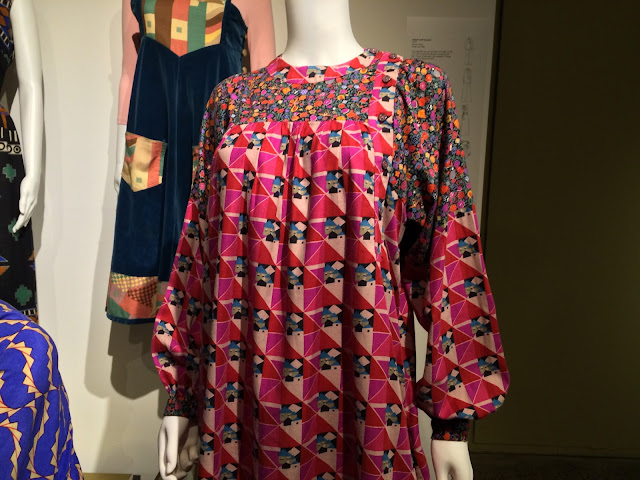The new exhibition at the Fashion and Textile Museum combines two of my favourite things: fashion and florals. Liberty In Fashion charts the history of the famous London shopping destination and the impact the brand and its designers had on British fashion. At the grand age of 140, Liberty has seen many changes in fashion and design but has maintained its place as an iconic institution, pioneering beautiful prints and bohemian designs.
The exhibition itself is a treasure-trove of ditsy prints, intricate embroidery and bright colours. It starts with the company's early days when it was set up by Arthur Liberty as a warehouse supplying fashionable goods and textiles from the Far East in the 1870s. Liberty then moved into creating beautiful embellished gowns, befitting the wardrobe of a Downton debutante, as shown in the image of the delicate ivory capelet below.
The beginning of the 20th century saw Liberty embrace the idea of 'Aesthetic Dressing'. Long, flowing kimonos inspired by japanese paintings became sought after lounge wear for the bohemian woman. Liberty began to not only look to the East for inspiration but started to reinterpret the farm labourer's staple - the smock - for modern women. Smocks were loose, comfortable garments which carried with them an air of nostalgia for a rustic and rural life, but also hinted at the wearer's artistic temperament as the perfect outfit for painting and writing. I particularly loved this embroidered smock below, with it's palette of green purple and white echoing that of the Suffragettes' uniform.
The fashion for smocks also extended to childrenswear and both boys and girls wear dressed in these smart but loose-fitting tunics. Children's author Kate Greenaway's illustrations, which revisited the clothing styles of the 1880s and 90s became inspiration for Liberty's childrenswear. I found it fascinating that imagined dress from storybooks could lead to real-life changes in children's clothing and remember the vogue for this as a nineties child dressed head to toe in Laura Ashley floral smock dresses!
Perhaps what Liberty is most associated with is it's iconic ditsy florals. These rose to fame in the interwar years of the 1920s and 30s when small prints on dark backgrounds of black or brown where popular. The lighter, more optimistic blues and pinks were favoured in the 1940s and were often made into pretty tea dresses (see below). Just looking at these gorgeous war-time outfits, with their nipped-in silhouettes and bakelite belts cheered me up. You can see where Cath Kidston get some of their nostalgic print ideas from.
Although Liberty reluctantly (to begin with) veered into more outlandish and vibrant prints in the 60s and 70s, when many of their prints were designed by the fabulous duo Susan Collier and Sarah Campbell, they returned to their trademark bohemian look in the 70s, with their floaty and romantic dresses (below). The smock dress made a triumphant return and prints were produced in beautiful muted browns and mauves. I loved the patchwork pinafores - they looked so practical and easy to wear.
Although I am probably biased, being already obsessed with prints and florals, I loved this exhibition of Liberty London. It was wonderful to learn about the shop's history, from its origins transporting textiles from across the world, to the work of its creative printmakers and design talents. Liberty will always hold a sense of nostalgia for me, but it was fascinating to see how often the brand has borrowed from the past to create something refreshing that echoes current fashions. Never more have I desired a few metres of Tana Lawn to make a ditsy print dress!
Let me know if you've been to the exhibition and what you thought of it - I'd love to know!
Liberty in Fashion is currently on at the Fashion Museum until 28th February 2016.






















































